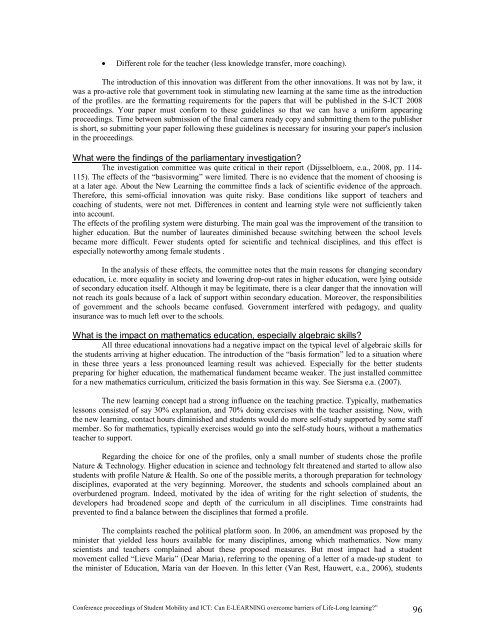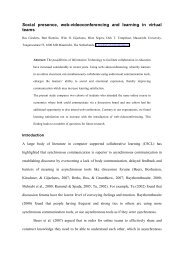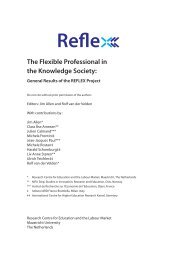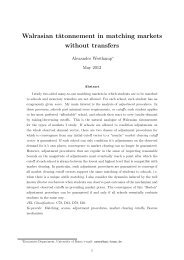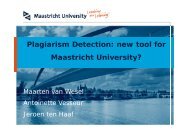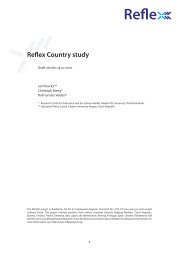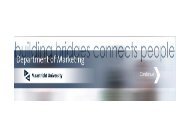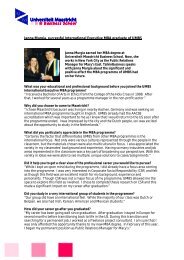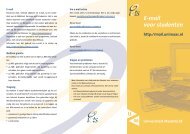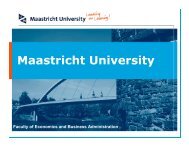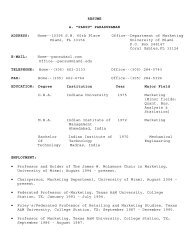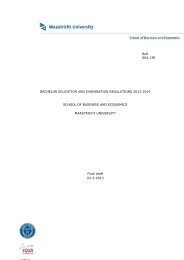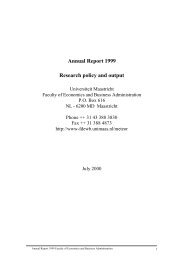proceedings of Student Mobility and ICT: Can E-LEARNING
proceedings of Student Mobility and ICT: Can E-LEARNING
proceedings of Student Mobility and ICT: Can E-LEARNING
Create successful ePaper yourself
Turn your PDF publications into a flip-book with our unique Google optimized e-Paper software.
• Different role for the teacher (less knowledge transfer, more coaching).<br />
The introduction <strong>of</strong> this innovation was different from the other innovations. It was not by law, it<br />
was a pro-active role that government took in stimulating new learning at the same time as the introduction<br />
<strong>of</strong> the pr<strong>of</strong>iles. are the formatting requirements for the papers that will be published in the S-<strong>ICT</strong> 2008<br />
<strong>proceedings</strong>. Your paper must conform to these guidelines so that we can have a uniform appearing<br />
<strong>proceedings</strong>. Time between submission <strong>of</strong> the final camera ready copy <strong>and</strong> submitting them to the publisher<br />
is short, so submitting your paper following these guidelines is necessary for insuring your paper's inclusion<br />
in the <strong>proceedings</strong>.<br />
What were the findings <strong>of</strong> the parliamentary investigation?<br />
The investigation committee was quite critical in their report (Dijsselbloem, e.a., 2008, pp. 114-<br />
115). The effects <strong>of</strong> the “basisvorming” were limited. There is no evidence that the moment <strong>of</strong> choosing is<br />
at a later age. About the New Learning the committee finds a lack <strong>of</strong> scientific evidence <strong>of</strong> the approach.<br />
Therefore, this semi-<strong>of</strong>ficial innovation was quite risky. Base conditions like support <strong>of</strong> teachers <strong>and</strong><br />
coaching <strong>of</strong> students, were not met. Differences in content <strong>and</strong> learning style were not sufficiently taken<br />
into account.<br />
The effects <strong>of</strong> the pr<strong>of</strong>iling system were disturbing. The main goal was the improvement <strong>of</strong> the transition to<br />
higher education. But the number <strong>of</strong> laureates diminished because switching between the school levels<br />
became more difficult. Fewer students opted for scientific <strong>and</strong> technical disciplines, <strong>and</strong> this effect is<br />
especially noteworthy among female students .<br />
In the analysis <strong>of</strong> these effects, the committee notes that the main reasons for changing secondary<br />
education, i.e. more equality in society <strong>and</strong> lowering drop-out rates in higher education, were lying outside<br />
<strong>of</strong> secondary education itself. Although it may be legitimate, there is a clear danger that the innovation will<br />
not reach its goals because <strong>of</strong> a lack <strong>of</strong> support within secondary education. Moreover, the responsibilities<br />
<strong>of</strong> government <strong>and</strong> the schools became confused. Government interfered with pedagogy, <strong>and</strong> quality<br />
insurance was to much left over to the schools.<br />
What is the impact on mathematics education, especially algebraic skills?<br />
All three educational innovations had a negative impact on the typical level <strong>of</strong> algebraic skills for<br />
the students arriving at higher education. The introduction <strong>of</strong> the “basis formation” led to a situation where<br />
in these three years a less pronounced learning result was achieved. Especially for the better students<br />
preparing for higher education, the mathematical fundament became weaker. The just installed committee<br />
for a new mathematics curriculum, criticized the basis formation in this way. See Siersma e.a. (2007).<br />
The new learning concept had a strong influence on the teaching practice. Typically, mathematics<br />
lessons consisted <strong>of</strong> say 30% explanation, <strong>and</strong> 70% doing exercises with the teacher assisting. Now, with<br />
the new learning, contact hours diminished <strong>and</strong> students would do more self-study supported by some staff<br />
member. So for mathematics, typically exercises would go into the self-study hours, without a mathematics<br />
teacher to support.<br />
Regarding the choice for one <strong>of</strong> the pr<strong>of</strong>iles, only a small number <strong>of</strong> students chose the pr<strong>of</strong>ile<br />
Nature & Technology. Higher education in science <strong>and</strong> technology felt threatened <strong>and</strong> started to allow also<br />
students with pr<strong>of</strong>ile Nature & Health. So one <strong>of</strong> the possible merits, a thorough preparation for technology<br />
disciplines, evaporated at the very beginning. Moreover, the students <strong>and</strong> schools complained about an<br />
overburdened program. Indeed, motivated by the idea <strong>of</strong> writing for the right selection <strong>of</strong> students, the<br />
developers had broadened scope <strong>and</strong> depth <strong>of</strong> the curriculum in all disciplines. Time constraints had<br />
prevented to find a balance between the disciplines that formed a pr<strong>of</strong>ile.<br />
The complaints reached the political platform soon. In 2006, an amendment was proposed by the<br />
minister that yielded less hours available for many disciplines, among which mathematics. Now many<br />
scientists <strong>and</strong> teachers complained about these proposed measures. But most impact had a student<br />
movement called “Lieve Maria” (Dear Maria), referring to the opening <strong>of</strong> a letter <strong>of</strong> a made-up student to<br />
the minister <strong>of</strong> Education, Maria van der Hoeven. In this letter (Van Rest, Hauwert, e.a., 2006), students<br />
Conference <strong>proceedings</strong> <strong>of</strong> <strong>Student</strong> <strong>Mobility</strong> <strong>and</strong> <strong>ICT</strong>: <strong>Can</strong> E-<strong>LEARNING</strong> overcome barriers <strong>of</strong> Life-Long learning?” 96


